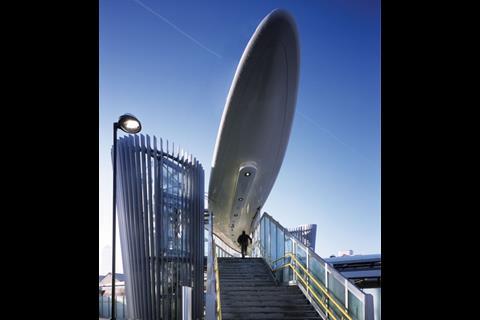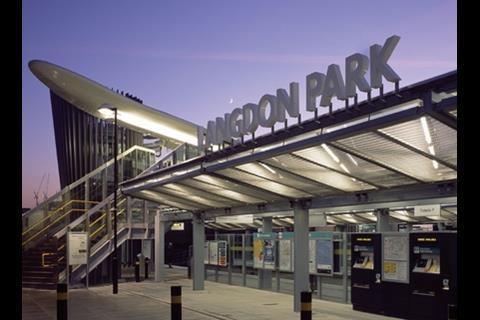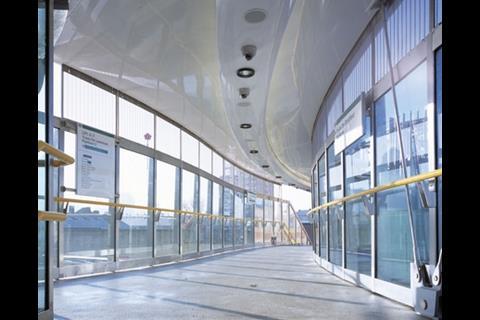When Consarc Consulting Architects set out to design a ‘landmark’ station for the Docklands Light Railway in a dreary part of east London, it took the unusual approach of topping it with a 32m white banana. And the even stranger thing, writes Martin Spring, is that it works …
These days, every new building aspires to be a landmark or an icon. In Consarc Consulting Architects’ write-up of its latest building, the word “landmark” occurs no fewer than four times.
The fact that the project being described is a small, two-platform station on a light railway line in east London may at first appear to bring the architect’s lofty prose down to earth with a bump. Until you take a look at the finished building.
Langdon Park station could be lost in the surrounding maze of minor streets were it not for the banana-shaped canopy that straddles the railway line and stretches out, without any sign of visible support, to either side. Sinuous and with a rounded edge, the canopy is so smooth and milky white that
it reflects the balustrading and the passengers passing beneath it. On either side, two two-storey baskets of vertical aluminium fins enclose compact glass passenger lifts.
The curving canopy seems to be frozen into a permanent cheery wave at passers-by.
At night, the canopy glows, while the lift baskets gleam like beacons. So if that is not a landmark – albeit a pocket-sized one – what is?
This flamboyant performance is not entirely gratuitous. The branch station on the Docklands Light Railway replaces an old footbridge across the tracks, and the banana-topped bridge linking the platforms maintains this right of way by being freely accessible to the public.
It also stands as a striking visual symbol of – and intended catalyst for – the regeneration of Bromley-by-Bow. This forms part of the government’s Thames Gateway housing expansion zone and lies just beyond London’s Olympic zone within the Lea Valley. Regeneration is already under way around the station, where an old industrial building is being demolished to make way for a high-rise residential scheme by East Thames Housing Association.
It was owing to the station’s major role in urban regeneration that London mayor Ken Livingstone was persuaded to preside over its official opening just before Christmas. At the event, Ohid Ahmed, councillor for the local ward in Tower Hamlets, said: “The council has been campaigning for this station for the past 10 years.” Added to that, some 6,000 local households were extensively consulted over the scheme.
The curving canopy seems to be frozen into a permanent cheery wave at passers-by. At night, the canopy glows, while the lift baskets gleam like beacons. If that is not a landmark, what is?
The building’s flamboyant design and bespoke elements, such as the glass-fibre canopy, glazed lifts and ETFE canopies over the platforms, pumped the project cost up to £7.5m, but much of this came out of the communities department’s special Community Infrastructure Fund.
According to Consarc’s project architect, Ed Holloway, the main concerns voiced by local residents were security and safety. Hardly surprising, given the hostile expanse of windowless, graffiti-covered brick walls that enclose the railway line and disused factories.
Consarc’s response was to go all out for accessibility and transparency, with no blind spots. Holloway says: “If you build a fortification, people treat it like that.”
The most obvious feature of such openness and accessibility is how the two platforms, as well as the stairs up to the footbridge, open directly off the public streets on either side. There are no intervening steps, ramps, screens or barriers, other than a few unobtrusive steel bollards to deter vehicles.
Tower Hamlets council has contributed to this by closing off one of the side streets to traffic and repaving it in york stone slabs to create a pedestrian square.
Even where screens or canopies are unavoidable, these are nearly all transparent in clear glazing. This includes the balustrading to the footbridge and the lift enclosures, with the latter protected against vandalism by a basket-shaped screen of aluminium fins. Even the canopies to the platforms are translucent ETFE pillows fritted with white polka dots that admit daylight.
The one aspect of the station that there has been an attempt to conceal is the CCTV system, with its grand total of 19 cameras inconspicuously built into the canopies and lifts-in-a-basket.
With its silky, sinuous fibreglass canopy and basket-like lift shafts, Langdon Park station really is a sculptural landmark that lights up its dull surroundings. It also shows signs of being a bright spark that is rekindling the area’s long-awaited urban regeneration. And, of course, it physically links the community directly to the rest of London through the DLR. As Holloway puts it: “It really is an optimistic community building.”
Project team
Client Docklands Light Railway
Architect Consarc Consulting Architects
Structural engineers SKM Anthony Hunts, Gifford
Services engineer Atkins
Economic development consultant URS Corporation
Cost consultant Gardiner & Theobald
Main contractor Costain
Downloads
Anatomy of a station
Other, Size 0 kb
Postscript
For more projects articles, log on to www.building.co.uk/projects



























![Hassell - Brighton Business School[1]](https://d3sux4fmh2nu8u.cloudfront.net/Pictures/100x67/7/4/1/1886741_hassellbrightonbusinessschool1_568688.jpg)



No comments yet